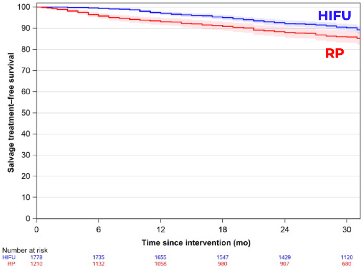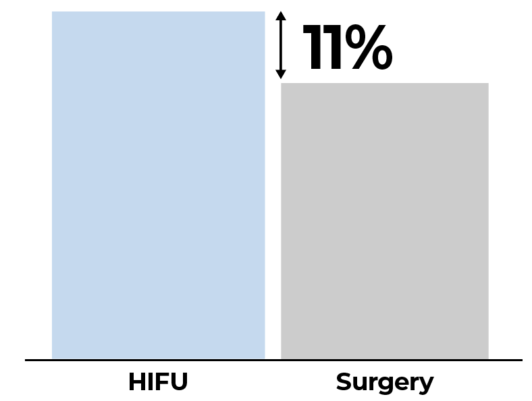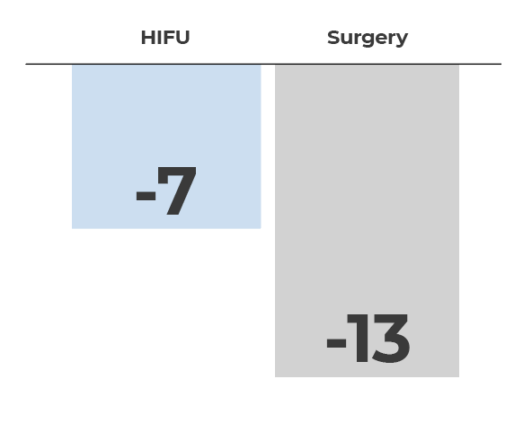The Prospective Non-inferiority Comparative Clinical Trial of Prostate Cancer Treatments
ClinicalTrials.org NCT#04307056 | Sponsored by AFU
The Prospective Non-inferiority Comparative Clinical Trial of Prostate Cancer Treatments
ClinicalTrials.com NCT#04307056Sponsored by AFU
HIFU vs Radical Prostatectomy For the Treatment of Prostate Cancer
- HIFI is the largest prospective comparative multi-center clinical study ever conducted evaluating oncologic and functional outcomes of localized prostate cancer treatments
- 3,328 prospective patients enrolled, including 1,967 consecutive HIFU patients and 1,361 Radical Prostatectomy (RP) patients across 46 centers.
- Study met both primary endpoint (non-inferior salvage treatment-free survival at 30 months) and secondary endpoint (favorable functional outcomes at 12 months)
HIFU vs Radical Prostatectomy For the Treatment of Prostate Cancer
- HIFI is the largest prospective comparative multi-center clinical study ever conducted evaluating oncologic and functional outcomes of localized prostate cancer treatments
- 3,328 prospective patients enrolled, including 1,967 consecutive HIFU patients and 1,361 Radical Prostatectomy (RP) patients across 46 centers.
- The Study met both primary endpoint (non-inferior salvage treatment free survival at 30 months) and secondary endpoint (favorable functional outcomes at 12 months)
Comparable Oncologic Outcomes
Non-Inferior Salvage Treatment-Free Survival Rate
at 30 months (Primary Endpoint)
Comparable Oncologic Outcomes
Non-Inferior Salvage Treatment-Free Survival Rate at 30 months (Primary Endpoint)



Prostate Cancer Control
Primary Endpoint: Salvage Treatment-free survival at 30 months.
Salvage Treatment is defined by the use of any salvage treatments such as Radical Prostatectomy (RP), Radiation Therapy (RT) and/or Androgen Deprivation Therapy (ADT) due to cancer progression.

Prostate Cancer Control
Primary Endpoint: Salvage Treatment-free survival at 30 months.
Salvage Treatment is defined by the use of any salvage treatments such as Radical Prostatectomy (RP), Radiation Therapy (RT) and/or Androgen Deprivation Therapy (ADT) due to cancer progression.
Superior Functional Outcomes
Favorable Urinary Continence and Erectile Function Preservation
at 12 months (Secondary Endpoint)
Superior Functional Outcomes
Favorable Urinary Continence and Erectile Function Preservation at 12 months (Secondary Endpoint)
Urinary Continence
Pad-Free Continence at 12 months

URINARY CONTINENCE
The International Continence Society (ICS) index, a measure of strict urinary incontinence (no leakage vs. at least one leakage per day), was significantly less deteriorated for HIFU (29%) vs, RP(44%) (RR=0.66 [95%CI, 0.59-0.74], p<0.001) for all ages combined.
Erectile Function
Decrease from baseline at 12 months

ERECTILE FUNCTION
The International Index of Erectile Function (IIEF), which measures erectile function, was significantly less reduced at 12 months after HIFU compared to RP with a difference in medians of -3.0 (-3.9; -2.1) between both groups.
“This nationwide trial is the first to prospectively comparing HIFU and surgery for the treatment of localized prostate cancer. The results demonstrate that medium-term salvage treatment-free outcomes are comparable with a better safety profile favoring HIFU.” – HIFI Study Authors
“This nationwide trial is the first to prospectively comparing HIFU and surgery for the treatment of localized prostate cancer. It demonstrates that mid-term salvage treatment outcomes are comparable with a better safety profile favoring HIFU.” – HIFI Study Authors
Prospective Study Design
3,328 patients: The Largest Prospective Comparative Study in Prostate Cancer Treatment
Prospective Study Design
3,328 Patients: The Largest Prospective Comparative Study in Prostate Cancer Treatment
PATIENT INCLUSION CRITERIA
The patient inclusion criteria was defined following the 2014 recommendations from the National Prostate Cancer Committee:
– Localized, low- to intermediate risk PCa
– Clinical Stage T1-2 NxM0
– Prostate Specific Antigen (PSA) dosage < 15 ng/mL

– Gleason score ≤ 3 + 4 (Grade Group 1 or 2)
– Not eligible for active surveillance (AS)
– Maximum of 4 invaded sextants out of 6 on biopsies performed following multiparametric MRI (mpMRI)
– HIFU was restricted to patients over 69 years old with at least a 5-year life expectancy
Patient Cancer Characteristics
Baseline disease characteristics are balanced between the two groups
Patient Cancer Characteristics
Baseline disease characteristics are balanced between the two groups

“The primary endpoint, 30-month STFS adjusted on the variable used to propensity score construction, was in the HIFU group 90% versus RP group 86%. Non-inferiority analysis showed that HIFU had a lower risk of ST compared to RP (HR=0.71[ 95%CI, 0.52-0.97], p=0.008). This result remains when focusing on GG2 (HR=0.66[ 95%CI, 0.50-165 0.86], p=0.001).” – HIFI Study Authors
“The primary endpoint, 30-month STFS adjusted on the variable used to propensity score construction, was in the HIFU group 90% versus RP group 86%. Non-inferiority analysis showed that HIFU had a lower risk of ST compared to RP (HR=0.71[ 95%CI, 0.52-0.97], p=0.008). This result remains when focusing on GG2 (HR=0.66[ 95%CI, 0.50-165 0.86], p=0.001).” – HIFI Study Authors
HIFI Study Conclusion
- The HIFI Study Successfully met the primary endpoint of non-inferior Salvage Treatment-free
- Survival (STFS) after HIFU compared to Radical Prostatectomy (RP) at 30 months:
Patients treated with HIFU had a significantly higher adjusted STFS at
30 months of 90% versus 86% STFS in patients who underwent RP. - Functional outcomes demonstrated better results with respect to urinary continence and erectile function in patients receiving HIFU therapy versus patients receiving RP.
HIFI Study Conclusion
- The HIFI Study Successfully met the primary endpoint of non-inferior Salvage Treatment-free
- Survival (STFS) after HIFU compared to Radical Prostatectomy (RP) at 30 months: Patients treated with HIFU had a significantly higher adjusted STFS at 30 months of 90% versus 86% STFS in patients who underwent RP.
- Functional outcomes demonstrated better results with respect to urinary continence and erectile function in patients receiving HIFU therapy versus patients receiving RP.
